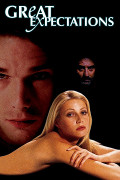
Directed by
Alfonso Cuaron
111 minutes
Rated M
Reviewed by
Bernard Hemingway

Great Expectations (1998)
Fans of Charles Dickens' enduring 1861 novel ‘Great Expectations’ will most likely be disappointed by Alfonso Cuarón’s bold screen adaptation.
For a start the time and place has been altered from the fog-shrouded Kentish moors in Victorian England to modern day Florida and New York. Then the novel’s convoluted plot has been stripped down to the long and winding romance between Finn (Pip in the original, probably to avoid legal issues most of the characters have been re-named) and Estella.
Cuarón’s version starts with Finn being called to the crumbling ruins of a neo-Gothic mansion, Paradiso Perduto, in which Miss Dinsmoor (a barely recognisable Anne Bancroft) has sequestered herself after having been abandoned at the altar decades earlier. There he meets Estella and although she is stand-offish they become companions of a sort as he entertains Miss Dinsmoor with his drawing skills.
Jump ten years forward to the main part of the story and Finn (now played by Ethan Hawke) who is working on a fishing boat for Joe (Chris Cooper) who raised him since Finn’s sister disappeared is approached by a lawyer (Josh Mostel) who offers him an exhibition of his work at a prestigious New York gallery. He re-encounters Estella (now played by Gwyneth Paltrow) and the embers of his infatuation with her burst into flame
If the first part of the film which deals with Finn’s youth including his encounter with an escaped convict (Robert DeNiro) remains reasonably true to Dicken’s original text the New York section takes flight with Finn being feted by the Soho avant-garde as the latest big thing. It is difficult to tell here if Cuarón expects us to take this development at face value or the whole thing is meant as a satirical parody of the Soho art scene. Given that Iggy Pop’s “Success’ is used to underscore the visuals and art scene pretensions abound, I presume the latter. Then again “Finn's” art (which keep being referred to as paintings despite being largely drawings) is actually by Italian artist Francesco Clemente who was big noise on the international art scene of the 1980’s. Shorn of this context they look pretty lame and why would Clemente would bite the hand that fed him so very well)?
Much the same considerations apply to a hyberbolically melodramatic scene (reminiscent of Marlon Brando’s famous “Stella” scene in A Streetcar Named Desire,1951) in which as rain pours downward and Patrick Doyle’s music surges upwards Finn brays his love to the unseen Estella. Surely this is a bit of genre camp?
Cuarón brings the story to a close with a clumsy rendition of Dicken’s Magwitch thread before settling on Dickens’ “soft” happily-ever-after ending. This ‘soft’ inclination indeed extends to the eroticization of Finn and Estella’s relationship commencing with a rather dubious scene of the youngsters sharing a drink from a garden fountain, a scene which admittedly is nicely re-iterated later when they are adults.
Cinematographer Emmanuel Lubezki’s work is impressive and shades of green are perhaps overused to tie scenes together visually and suggestive of a rich connotative set - variously envy, decay, greed (much more so than hope, new growth, what have you).
Cuarón’s film is more “inspired by” than an adaptation of Dicken’s novel as was David Lean’s classic 1946 version and Mike Newell's bungled 2012 version. Somewhat ironically it is when it hews to the original text that it is most watchable.
Want something different?





